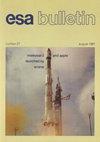APOLLO - A satellite-based information distribution system
Q4 Earth and Planetary Sciences
引用次数: 2
Abstract
APOLLO (Article Procurement with On-Line Local Ordering) originates from the desire to complement on-line search and ordering of bibliographical references with an electronic delivery of the required document. Early investigations into the market and application requirements were initiated by the European Commission. It was soon concluded that only a satellite link could provide the envisaged transmission capacity, and since no practical system concept existed at that time, the Commission, Eutelsat, members of the CEPT and the European Space Agency (ESA) joined in a working group. During 1983, this group produced outline specifications for a generalised concept for electronic document delivery. At the end of 1984, the Joint Communication Programme Board of ESA approved APOLLO as a co-operative programme, in which ESA would provide the APOLLO-specific equipments and the participating PTT administrations would provide transmitting earth stations. Detailed specifications for the APOLLO system were then developed by ESA staff in close co-operation with the other participants. The major objective was to realise APOLLO as a data dissemination service with a limited number of source stations and an unlimited number of small, low-cost, receive-only earth stations. Development contracts with industry were awarded during 1985-86. Practically all equipment has already been delivered and used in satellite transmission tests. Overall system demonstrations have been successfully completed during the first half of 1989.阿波罗-一个基于卫星的信息分发系统
APOLLO(物品采购与在线本地订购)源于希望通过电子交付所需文件来补充在线搜索和书目参考文献的订购。欧盟委员会启动了对市场和应用要求的早期调查。很快得出的结论是,只有卫星链路才能提供设想的传输能力,由于当时没有实际的系统概念,委员会、欧洲通信卫星组织、欧洲通信技术委员会成员和欧洲空间局(欧空局)加入了一个工作组。在1983年期间,该小组为电子文档传递的一般概念制定了概要规范。1984年底,欧空局联合通信方案委员会核可阿波罗计划作为一个合作方案,欧空局将提供阿波罗计划专用设备,参与的PTT管理部门将提供发射地面站。随后,欧空局工作人员与其他参与者密切合作,制定了阿波罗系统的详细规格。主要目标是将阿波罗作为一种数据传播服务来实现,它拥有数量有限的源站和数量无限的小型、低成本、只接收信号的地面站。1985-86年期间与工业界签订了发展合同。几乎所有设备都已交付并用于卫星传输试验。整个系统的演示已于1989年上半年顺利完成。
本文章由计算机程序翻译,如有差异,请以英文原文为准。
求助全文
约1分钟内获得全文
求助全文
来源期刊

Esa Bulletin-European Space Agency
工程技术-工程:宇航
CiteScore
0.12
自引率
0.00%
发文量
0
审稿时长
>12 weeks
期刊介绍:
The ESA Bulletin is ESA’s flagship magazine, published four times a year, describing ESA"s work for a general audience i.e., the space-interested public, stakeholders and decision-makers. It contains an attractive, highly readable mix of informative and in-depth articles, news items and technical project updates.
 求助内容:
求助内容: 应助结果提醒方式:
应助结果提醒方式:


